Disclosure: We may earn commissions if you purchase products after clicking on a link from our site.
Would you like to catch more weakfish? Are you searching for weakfish fishing tips to take more home? Weakfish are known to be lazy feeders. They linger in holes and wait for their prey. This behavior makes weakfish a prime target for anglers. In this article, we share weakfish fishing tips from years of fishing this gamefish to help you learn how to catch more.
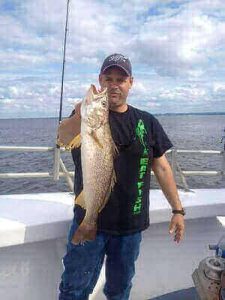
Table of Contents
How To Catch Weakfish
1. Bait Casting
Baitcasting is a preferred fishing method among anglers targeting weakfish, also known as seatrout, a popular saltwater gamefish prized for its fighting ability and delicious flesh. Utilizing a baitcasting reel paired with a medium to heavy action rod, anglers can effectively target weakfish in various coastal environments such as estuaries, bays, and tidal rivers.
The baitcasting setup allows for precise casting accuracy and control, crucial when presenting baits or lures in areas where weakfish are likely to ambush their prey. Common bait choices for baitcasting include live or cut baitfish such as mullet, menhaden, or shrimp, rigged on a Carolina or fish-finder rig to keep the bait near the bottom where weakfish often feed.
Additionally, anglers may opt for artificial lures such as soft plastics, bucktails, or swimming plugs, which can be cast accurately using baitcasting gear and retrieved at varying speeds to mimic the movements of natural prey. Baitcasting offers anglers the versatility and control needed to effectively target weakfish, making it a favored method among seasoned anglers seeking to land these elusive and prized gamefish.
2. Drift Fishing
Drift fishing is a popular and effective method employed by anglers targeting weakfish, also known as seatrout, a prized saltwater gamefish sought after for its spirited fight and delectable flesh. In drift fishing, anglers allow their boat to move naturally with the current while presenting baits or lures along the way.
This technique is particularly effective in expansive coastal environments such as estuaries, bays, and tidal rivers where weakfish often congregate in search of prey. Anglers can deploy a variety of bait options for drift fishing, including live or cut baitfish such as mullet, menhaden, or shrimp, rigged on a Carolina or fish-finder rig to keep the bait near the bottom where weakfish frequently feed.
Additionally, artificial lures such as soft plastics, bucktails, or swimming plugs can be used effectively in drift fishing, allowing anglers to cover a wide area and entice weakfish into striking. Drift fishing offers anglers the flexibility to explore different depths and locations while presenting baits or lures naturally and enticingly, making it a favored method among anglers seeking to land these elusive and prized gamefish.
3. Still Fishing
Still fishing, also known as bottom fishing, is a popular and effective method used by anglers to target weakfish, a prized saltwater gamefish known for its spirited fight and delicious flesh. In still fishing, anglers anchor their boat in areas known to hold weakfish, such as channels, drop-offs, or submerged structures, and present baits or lures directly to the fish below.
Common bait choices for still fishing include live or cut baitfish such as mullet, menhaden, or shrimp, rigged on a Carolina or fish-finder rig to keep the bait near the bottom where weakfish often feed. Additionally, anglers may opt for artificial lures such as soft plastics, bucktails, or swimming plugs, which can be jigged or retrieved slowly along the bottom to mimic the movements of natural prey.
Still fishing allows anglers to target specific areas where weakfish are known to frequent and present baits or lures in a controlled manner, increasing the likelihood of enticing strikes. With its simplicity and effectiveness, still fishing remains a favored method among anglers seeking to land these elusive and prized gamefish.
4. Surf Casting
Surf casting is a popular and productive fishing method utilized by anglers to target weakfish, a prized saltwater gamefish known for its spirited fight and delicious flesh. Anglers typically employ long surf rods paired with spinning or baitcasting reels to cast their baits or lures into the surf from the shoreline.
Weakfish often patrol the surf zone in search of baitfish and crustaceans, making it an ideal environment for surf casting. Common bait choices for surf casting include live or cut baitfish such as mullet, menhaden, or shrimp, as well as artificial lures such as soft plastics, bucktails, or swimming plugs. Anglers may also use specialized rigs such as pompano rigs or fish-finder rigs to keep the bait near the bottom where weakfish often feed.
Surf casting requires skill and accuracy to cast baits or lures beyond the breaking waves and into the deeper waters where weakfish are likely to be found. With its combination of skill and strategy, surf casting offers anglers an exhilarating and rewarding experience as they seek to land these elusive and prized gamefish from the shoreline.
5. Fly Fishing
Fly fishing for weakfish, a prized saltwater gamefish known for its spirited fight and delicious flesh, offers anglers a unique and exhilarating experience. Anglers typically use specialized fly fishing rods, reels, and lines designed for saltwater environments to cast lightweight flies to their target.
Weakfish are often found in shallow coastal waters, estuaries, and tidal rivers, making them accessible to fly anglers from shore or boat. Common fly patterns for weakfish include Clouser Minnows, Deceivers, and shrimp or crab imitations tied with vibrant colors and materials that mimic the natural prey of weakfish.
Anglers may also use sinking lines or sinking-tip lines to present flies at varying depths, depending on the water conditions and the behavior of the fish. Fly fishing for weakfish requires precision casting and keen observation of the water to identify feeding fish and present the fly effectively. With its technical skill and intimate connection to the water, fly fishing offers anglers a rewarding and immersive way to pursue these elusive and prized gamefish.
6. Bottom Fishing
When bottom fishing, you drop your bait to the bottom and slowly bring it up just above the bottom to entice a strike from fish. Bottom fishing is a widely practiced and effective method for targeting weakfish, a prized saltwater gamefish known for its spirited fight and delectable flesh.
Anglers typically anchor their boats in areas known to hold weakfish, such as channels, drop-offs, or around submerged structure, and present baits directly to the fish below. Common bait choices for bottom fishing include live or cut baitfish such as mullet, menhaden, or shrimp, rigged on a Carolina or fish-finder rig to keep the bait near the bottom where weakfish often feed.
Additionally, anglers may use artificial lures such as soft plastics, bucktails, or swimming plugs, which can be jigged or retrieved slowly along the bottom to mimic the movements of natural prey. Bottom fishing allows anglers to target specific areas where weakfish are known to frequent and present baits or lures in a controlled manner, increasing the likelihood of enticing strikes. With its simplicity and effectiveness, bottom fishing remains a favored method among anglers seeking to land these elusive and prized gamefish.
7. Night Fishing
Night fishing is a popular and productive method employed by anglers to target weakfish, a prized saltwater gamefish known for its spirited fight and delicious flesh. Weakfish are often more active during the nighttime hours, making night fishing an ideal strategy for anglers looking to capitalize on their feeding behavior.
Anglers typically anchor their boats in areas known to hold weakfish, such as channels, drop-offs, or around submerged structures, and present baits directly to the fish below. Common bait choices for night fishing include live or cut baitfish such as mullet, menhaden, or shrimp, rigged on a Carolina or fish-finder rig to keep the bait near the bottom where weakfish often feed.
Additionally, anglers may use artificial lures such as soft plastics, bucktails, or swimming plugs, which can be jigged or retrieved slowly along the bottom to mimic the movements of natural prey. Night fishing offers anglers a peaceful and serene experience on the water while providing ample opportunities to hook into these elusive and prized gamefish. With its unique challenges and rewards, night fishing remains a favored method among anglers seeking to land weakfish under the cover of darkness.
Weakfish Fishing Tackle
A 6 to 7-foot light to medium spinning rod with a 12-pound braided line paired with an 8 to 12-pound fluorocarbon leader will work for catching weakfish.
How To Catch Weakfish In The Surf
When fishing for weakfish in the surf, look for jetties, drop-offs, ledges, deep holes, and inlets, that weakfish may be around, waiting in ambush for baitfish. Study the wind, the tides, and the current. You want the wind working together with the tide or current. If the wind is working against the tide, that is not the best condition for weakfish fishing.
Additionally, look for moving water. Very large weakfish sit in holes and wait for baitfish to come their way. When the water movement changes direction, weakfish face the current, waiting for baitfish to swim by.
The time of the day you fish for weakfish is also important. Fishing early in the morning is the best time to catch weakfish. At this time, there will be less boat traffic and minimum winds which makes it ideal for targeting weakfish.
When fishing for weakfish in the surf, the tide is important. There is a reason why weakfish are called “tide runners”. Fish near the inlets when the tide is strong. By studying the tide, you can expand your search for weakfish to deep holes and large contour changes in bays that can be seen by your fish finder or sonar device.
You will find weakfish in deep holes and along edges where they can ambush baitfish as a strong tide delivers baitfish to it as it waits. Look for significant changes in the bottom contour. Depth changes of ledges are ambush spots for weakfish. They will be in that area waiting to ambush baitfish.
How To Catch Weakfish In New Jersey
In late spring, weakfish can be found in deep channels of back bays around confluence points. Also, look for weakfish in overhangs and sedge points.
During the summer, look for weakfish around structures like bridge pilings and docks. They will be in the tides preying on baitfish, grass shrimp, and crustaceans. Weakfish can also be found in backwaters, bays, and river and canal systems. In the fall, weakfish will leave the surf and travel along the coast feeding on sand eels.
Casting using lures like soft plastics or bucktails works well when fishing for weakfish in New Jersey. They tend to be attracted to pink or purple color patterns. Additionally, they like long and lean baits.
When fishing for weakfish with lures, slowly reel the lure so that it moves steadily through the water column without jigging it. This is very effective on flats and the edges of channel bays as they like steady bait. When fishing for weakfish around deeper holes and cuts, small bucktails can be used at the bottom and then jigged slowly off the bottom.
How To Catch Weakfish On Long Island
Weakfish will hang around different structures as they wait in ambush for prey. Bridge pilings, docks, and other structures are some of the structures to target. Additionally, they can also be found around significant depth changes like drop-offs, jetties, deep holes, inlets, and ledges.
Use baits and lures when fishing for them on Long Island. They are attracted to the color pink. Therefore use pink or white lures to catch more weakfish. Casting, bottom fishing, trolling, drift fishing, jigging, and night fishing are some of the fishing methods used when fishing for weakfish.
How To Catch Weakfish In Rhode Island
When fishing for weakfish in Rhode Island, look for them around structures, drop-offs, ledges, and jetties. Use lures like soft plastics and jigs when fishing for weakfish. Weakfish are attracted to pink. Using pink lures will increase your chances of catching more weakfish. Casting, bottom fishing, trolling, drifting, and night fishing can be used to catch weakfish in Rhode Island.
Weakfish Fishing Tips
1. If you are fishing for weakfish in fast-moving water, use a lure that will get into the holes where weakfish are situated in.
2. Weakfish like to gather in deep holes and along the edges where ambushing their prey is possible. When there is a strong tide, they are rewarded with their prey.
3. Tip your jig with a squid strip if you want to use natural bait. You can also use sandworms on a high-low rig.
4. Weakfish are called the “tide runner” as they hang around areas where the tide runs the strongest like inlets. Study the tide tables to expand your search for areas where they may be lurking.
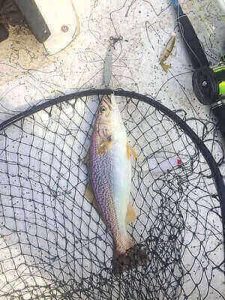
5. Be on the lookout for areas where there is a major change in the bottom contour that features a ledge dropping from 5 to 25 feet. Weakfish use areas with such a depth change as an ambush area for their prey.
6. Be very observant of the surroundings. Look for areas where birds are diving into the water near jetties. Watch out for activities close to inlets. If the birds are feeding on shrimp in that area, it can possibly be an area of interest for weakfish.
7. Look for many spots where weakfish might be lingering in waiting to ambush their prey. It may not be possible to fish in some areas due to wind, tide, weather, etc. on some days. This will allow you to fish in other areas that you are aware of that weakfish linger in.
8. It is often stated that where there is a tide, weakfish will be there. Though that is true, what is more, important is moving water. Weakfish feed on both sides of the tides. Due to the currents, there is moving water. Find the moving water as weakfish face the current waiting for an easy meal to come their way.
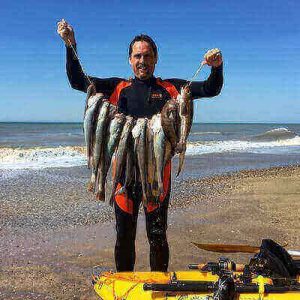
9. The time of day is very important when it comes to catching big spring weakfish. Leave early at pre-dawn when there is little boat traffic and minimum winds. Weakfish want to avoid the heavy boat traffic and strong winds will be out there feeding. Target channels and coves inside inlets at this time.
10. When you are fishing for weakfish, you want to find fishing conditions with the wind working with the current or tide. If they are working against each other, that will not help in targeting weakfish.
11. The rod you use to catch Weakfish is very important. The rod you choose needs to have enough flexibility during the initial hookup.
12. When no other lure or bait works for weakfish, shrimps will do the trick.
13. When hooking shrimp baits, thread the first shrimp on the hook. Then take two to three more and hook them through the body to fill the hook. Weakfish can’t ignore a ball of shrimp. There will be hits, be prepared.
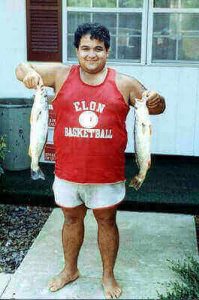
14. If you want to target tide runners, use soft plastics.
15. Weakfish simply just hang on to the plastic. They don’t commit to it as a bass or bluefish will do. Therefore, you want to slowly reel in the bait. Don’t jerk or jig it. You will lose the weakfish.
16. When fishing for weakfish at night, replace the plastic baits with noisemakers.
17. If you fish for weakfish during low tide instead of high tide, then focus on the holes where weakfish go during low tide.
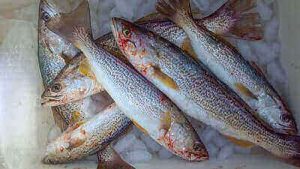
18. The temperature of the water is important when fishing weakfish. Monitor the temperature. When the temperature is at or above 59 degrees, weakfish will bite the best. You can use natural baits at 55 degrees, but to catch eakfish with artificial lures, the water has to be warmer than 57 degrees.
If the temperature rises above 74 degrees for three days, it will feed at night. Take along an inexpensive water thermometer to help with targeting weakfish.
19. Using the right lure colors, you can fish for weakfish in murky waters. However, if the water is too dirty, fishing for weakfish will be poor.
20. If there are extended periods of heavy rainfall, weakfish will move out of the back bay areas. It can take up to 7 days of dry weather for their return. However, fishing can be back on after three days.
21. Weakfish bite the best when there are larger tides brought on by full and new moons. Two hours before and two hours after low or high tide is the best time to get bites from weakfish, especially when the tide phase is close to dawn or dusk.
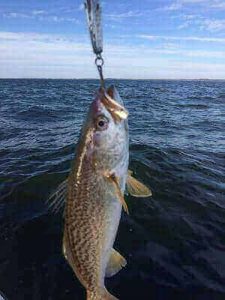
22. Water temperature will determine the most productive tide early and late in the season. During the early spring, the end of the outgoing tide is best, and late in fall, the end of the incoming tide is best.
23. Weakfish will not bite while spawning late in spring. After spawning, the biting will ramp up. Remember this to avoid frustration.
24. Rock jetties, bridges, mussel beds, edges, pilings, marsh banks, and temperature breaks are all places where weakfish reside. However, how well the structure produces weakfish will be determined by where it is located.
Factors that affect how well the structure produces are the current in that area, the salt level, the type of bottom, water clarity, and depth. Weakfish usually will reside in a good structure for the entire season. So if you find a hot spot, be ready for the reward in weakfish.
25. Weakfish are also attracted by lighted docks and bridges. Watch out for feeding weakfish as you may discover these docks and lights where the weakfish are feeding. Quietly approach this area to avoid spooking them.
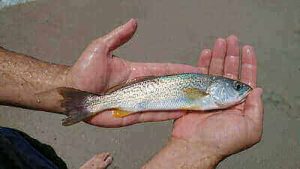
26. If your presentation is not natural, regardless of the bait or lure you are using, you will not catch weakfish. Do not retrieve against the current as it makes for a poor presentation. To have a natural presentation and get bites, fish the lure or bait with the current.
27. Always use a slow, steady retrieve that allows your lure to move through the strike zone and avoid getting stuck on the structure. You will get strikes by lifting and dropping a lure along the bottom when there is a school of weakfish holding tight to the bottom during slack tide.
28. Always cast up-tide. Change your location if you can’t hit the strike zone with an up-tide cast.
29. Quickly and aggressively set the hook when you feel the hit. Keep the line tight when the hook is set. Make sure to set the drag a little lighter than what you would do for bluefish to avoid pulling the hook from the weakfish.
30. Missing the beginning of the tide doesn’t mean you won’t get fish. You will experience a “pick” until the next tide rolls in.
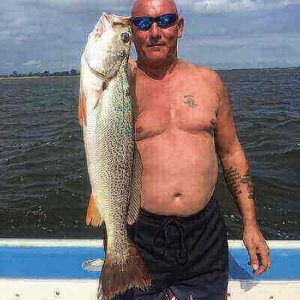
Weakfish Lures & Bait
1. Shrimp
Shrimp are highly effective and versatile bait for anglers targeting weakfish, a prized saltwater gamefish known for its spirited fight and delicious flesh. These crustaceans are a natural prey item for weakfish, making them an enticing option for anglers seeking to entice strikes. Anglers typically rig live or fresh shrimp on a hook using a Carolina rig or fish-finder rig to keep the bait near the bottom where weakfish often feed.
Shrimp can also be used as cut bait, with anglers threading sections of shrimp onto the hook to release their natural scent and attract fish. Additionally, artificial shrimp lures, such as soft plastics or shrimp imitations, can be effective when jigged or retrieved slowly along the bottom to mimic the movements of live prey.
Shrimp are readily available at bait shops and can be easily stored and transported, making them a convenient and reliable bait option for weakfish fishing. With their natural appeal and proven effectiveness, shrimp provide anglers with a versatile and rewarding option for pursuing these elusive and prized gamefish.
2. Soft Plastics
Soft plastics are highly effective lures for anglers targeting weakfish, a prized saltwater gamefish known for its spirited fight and delicious flesh. These artificial baits come in a variety of shapes, sizes, and colors, allowing anglers to match the hatch and entice strikes from wary fish.
Common soft plastic lures for weakfish fishing include shrimp imitations, curly-tail grubs, and jerk baits, which can be rigged on jigheads or weighted hooks and presented at various depths in the water column. Anglers can impart lifelike action to soft plastics by jigging them off the bottom or retrieving them with a steady or erratic motion to mimic the movements of natural prey.
Soft plastics are versatile lures that can be used in both shallow and deep water, as well as in various fishing environments such as estuaries, bays, and tidal rivers. With their realistic appearance, enticing action, and durability, soft plastics provide anglers with a reliable and rewarding option for pursuing weakfish, ensuring an enjoyable and productive fishing experience on the water.
3. Jigs
Jigs are highly effective lures for anglers targeting weakfish, a prized saltwater gamefish known for its spirited fight and delicious flesh. These versatile artificial baits consist of a weighted head and a trailing hook, often adorned with soft plastic bodies or feathers to mimic the appearance of baitfish or crustaceans.
Anglers can choose from a variety of jig styles, including bucktail jigs, paddle tail jigs, or tube jigs, depending on the fishing conditions and the preferences of the fish. Jigs can be casted, jigged vertically, or trolled behind a boat, allowing anglers to cover a wide range of depths and water columns where weakfish are likely to be found.
By varying the retrieve speed and cadence, anglers can imitate the movements of natural prey and entice strikes from wary fish. Jigs are versatile lures that excel in both shallow and deep water, making them a favored choice among anglers seeking to land weakfish in a variety of fishing environments such as estuaries, bays, and tidal rivers.
4. Squid
Squid is a highly effective bait for anglers targeting weakfish, a prized saltwater gamefish known for its spirited fight and delectable flesh. Squid has a strong scent and a texture that entices weakfish to strike.
Anglers typically rig squid by threading strips onto a hook or using whole squid as bait. Squid can be used in combination with other baits or on its own, depending on angler preference and fishing conditions. Its natural appearance and enticing scent make squid a popular choice for anglers seeking to land weakfish in a variety of environments such as estuaries, bays, and tidal rivers.
5. Live Bait
Live bait is an incredibly effective and versatile option for anglers targeting weakfish, a prized saltwater gamefish known for its spirited fight and delectable flesh. Common live baits used for weakfish fishing include mullet, menhaden, shrimp, and squid, among others.
These baits are rigged on hooks using Carolina rigs, fish-finder rigs, or other appropriate setups to keep the bait near the bottom where weakfish often feed. Live bait emits natural scents and movements that entice weakfish to strike, making it an irresistible option for anglers.
Additionally, live bait allows anglers to adapt to changing fishing conditions and target specific areas where weakfish are known to congregate. Whether fishing from a boat or the shoreline, live bait provides anglers with a reliable and rewarding option for pursuing these elusive and prized gamefish, ensuring an enjoyable and productive fishing experience on the water.
6. Spoons
Spoons are effective lures for anglers targeting weakfish, a prized saltwater gamefish known for its spirited fight and delicious flesh. These metal lures come in a variety of shapes, sizes, and finishes, allowing anglers to match the hatch and entice strikes from wary fish.
Common spoon designs for weakfish fishing include flutter spoons, casting spoons, and jigging spoons, each offering its own unique action and appeal to fish. Anglers can cast spoons into areas where weakfish are known to congregate, such as channels, drop-offs, or around submerged structures, and retrieve them with a steady or erratic motion to mimic the movements of natural prey.
The flash and vibration produced by spoons can attract the attention of weakfish, enticing them into striking. Spoons are versatile lures that can be used in both shallow and deep water, as well as in various fishing environments such as estuaries, bays, and tidal rivers. With their realistic appearance, enticing action, and proven effectiveness, spoons provide anglers with a reliable and rewarding option for pursuing weakfish, ensuring an enjoyable and productive fishing experience on the water.
7. Plugs
Plugs are versatile and effective lures for anglers targeting weakfish, a prized saltwater gamefish known for its spirited fight and delicious flesh. These hard-bodied lures come in various shapes, sizes, and diving depths, allowing anglers to cover a wide range of water columns and fishing conditions.
Common plug designs for weakfish fishing include diving plugs, surface poppers, and twitch baits, each offering its own unique action and appeal to fish. Anglers can cast plugs into areas where weakfish are known to congregate, such as channels, drop-offs, or around submerged structure, and retrieve them with a variety of techniques to mimic the movements of natural prey.
The realistic appearance and enticing action of plugs can attract the attention of weakfish, enticing them into striking. Plugs are versatile lures that can be used in both shallow and deep water, as well as in various fishing environments such as estuaries, bays, and tidal rivers. With their proven effectiveness and widespread popularity, plugs provide anglers with a reliable and rewarding option for pursuing weakfish, ensuring an enjoyable and productive fishing experience on the water.
8. Cut Bait
Cut bait is a highly effective and popular choice among anglers targeting weakfish, a prized saltwater gamefish known for its spirited fight and delicious flesh. Cut bait refers to sections of fresh or frozen fish, such as mullet, menhaden, or squid, that are cut into smaller pieces and rigged on hooks to attract weakfish.
Anglers typically use a Carolina rig or fish-finder rig to keep the cut bait near the bottom where weakfish often feed. The scent and oils released by cut bait create a strong attractant that can entice weakfish to strike, even in murky or low-visibility conditions.
Cut bait is versatile and can be used from both boats and shorelines, making it a preferred option for anglers fishing in a variety of environments such as estuaries, bays, and tidal rivers. With its natural appeal and proven effectiveness, cut bait provides anglers with a reliable and rewarding option for pursuing weakfish, ensuring an enjoyable and productive fishing experience on the water.
9. Crabs
Crabs are a natural and effective bait for anglers targeting weakfish, a prized saltwater gamefish known for its spirited fight and delectable flesh. Soft-shell crabs, blue crabs, and fiddler crabs are commonly used as bait for weakfish fishing. These crustaceans are often found in the same areas as weakfish, making them an enticing option for anglers looking to entice strikes.
Anglers typically rig crabs by threading them onto a hook or using them whole as bait. Crabs emit natural scents and movements that attract weakfish, enticing them to strike. Additionally, the tough outer shell of crabs provides durability, allowing anglers to make multiple casts without having to replace the bait frequently.
10. Mollusks
Mollusks, such as clams, mussels, and oysters, can be effective baits for anglers targeting weakfish, a prized saltwater gamefish known for its spirited fight and delicious flesh. These shellfish are commonly found in the same habitats as weakfish, making them a natural and enticing option for anglers looking to entice strikes.
Mollusks are usually rigged by threading them onto a hook or using them whole as bait. Mollusks emit natural scents and flavors that attract weakfish, enticing them to strike. Additionally, the texture and durability of mollusk meat allow it to stay on the hook well, even in strong currents or when casting long distances.
11. Herring
Herring is a highly effective and versatile bait for anglers targeting weakfish, a prized saltwater gamefish known for its spirited fight and delicious flesh. This oily and flavorful baitfish emits a strong scent that can attract weakfish from a distance, making it an irresistible option for anglers looking to entice strikes.
Anglers typically rig herring by threading it onto a hook or using it whole as bait. Herring can also be cut into strips or chunks to release even more scent into the water, further enticing weakfish to strike.
Additionally, the oily nature of herring helps it to stay on the hook well, even in strong currents or when casting long distances. Whether fishing from a boat or the shoreline, herring offers anglers a reliable and effective option for pursuing weakfish, ensuring an enjoyable and productive fishing experience on the water.
12. Menhaden
Menhaden, also known as bunker or pogy, are one of the most popular and effective baits for anglers targeting weakfish, a prized saltwater gamefish known for its spirited fight and delicious flesh. These oily baitfish emit a strong scent that can attract weakfish from a distance, making them an irresistible option for anglers looking to entice strikes.
Anglers typically rig menhaden by threading them onto a hook or using them whole as bait. Menhaden can also be cut into strips or chunks to release even more scent into the water, further enticing weakfish to strike.
Additionally, the oily nature of menhaden helps them to stay on the hook well, even in strong currents or when casting long distances. Whether fishing from a boat or the shoreline, menhaden offers anglers a reliable and effective option for pursuing weakfish, ensuring an enjoyable and productive fishing experience on the water.
13. Silversides
Silversides are a favored bait choice among anglers targeting weakfish, a prized saltwater gamefish known for its spirited fight and delectable flesh. These small, shiny fish are abundant in coastal waters and estuaries, making them readily available for anglers to use as bait.
Silversides emit a natural shine and subtle movement in the water that can attract the attention of weakfish, enticing them to strike. Anglers typically rig silversides by threading them onto a hook or using them whole as bait.
Additionally, silversides can be cut into strips or chunks to release more scent and further entice weakfish. The versatility and availability of silversides make them an excellent bait choice for anglers seeking to pursue weakfish in a variety of fishing environments, from shallow flats to deeper channels. Whether fishing from a boat or the shoreline, using silversides as bait can enhance an angler’s chances of success and ensure an enjoyable and productive fishing experience on the water.
14. Killifish
Killifish, also known as mud minnows, are a popular and effective bait choice for anglers targeting weakfish, a prized saltwater gamefish known for its spirited fight and delicious flesh. These small fish are abundant in coastal waters and estuaries, making them readily available for anglers to use as bait. Killifish emit natural movements and scents that can attract the attention of weakfish, enticing them to strike.
Anglers typically rig killifish by threading them onto a hook or using them whole as bait. Additionally, killifish can be cut into strips or chunks to release more scent and further entice weakfish. The versatility and availability of killifish make them an excellent bait choice for anglers seeking to pursue weakfish in a variety of fishing environments, from shallow flats to deeper channels. Whether fishing from a boat or the shoreline, using killifish as bait can enhance an angler’s chances of success and ensure an enjoyable and productive fishing experience on the water.
15. Butterfish
Butterfish is a sought-after bait choice among anglers targeting weakfish, a prized saltwater gamefish known for its spirited fight and delectable flesh. These small, silver-colored fish are abundant in coastal waters and estuaries, making them an ideal option for anglers seeking to entice strikes from weakfish.
Butterfish emit natural movements and scents that can attract the attention of weakfish, enticing them to strike. Anglers typically rig butterfish by threading them onto a hook or using them whole as bait.
Additionally, butterfish can be cut into strips or chunks to release more scent and further entice weakfish. The availability and attractiveness of butterfish make them a favored bait choice for anglers seeking to pursue weakfish in various fishing environments, from shallow flats to deeper channels. Whether fishing from a boat or the shoreline, using butterfish as bait can increase an angler’s chances of success and ensure a rewarding fishing experience on the water.
16. Swimbaits
Swimbaits are a popular and effective lure choice for anglers targeting weakfish, a prized saltwater gamefish known for its spirited fight and delicious flesh. These soft plastic lures are designed to mimic the appearance and swimming action of baitfish, making them irresistible to predatory species like weakfish.
Swimbaits come in various sizes, shapes, and colors, allowing anglers to match the local forage and conditions. Anglers typically rig swimbaits on jigheads or weighted hooks and retrieve them with a steady, rhythmic motion to mimic the natural swimming action of prey fish. The lifelike movement and appearance of swimbaits can attract the attention of weakfish, enticing them to strike. Swimbaits are versatile lures that can be used in a variety of fishing environments, including estuaries, bays, and tidal rivers.
The Bottom Line
The weakfish is referred to as the “tide runner” as it likes to linger in holes and wait to ambush its prey. They eat just about anything and are a prime target for anglers. In this article, we share weakfish fishing tips to help you become a better angler and catch more weakfish whether you are a beginner or an experienced angler.
You can read how to catch spotted seatrout, how to catch sand seatrout and redfish fishing tips. If you also fly fish with nymphs, this article about fly fishing with nymphs will help you catch more fly fish.

